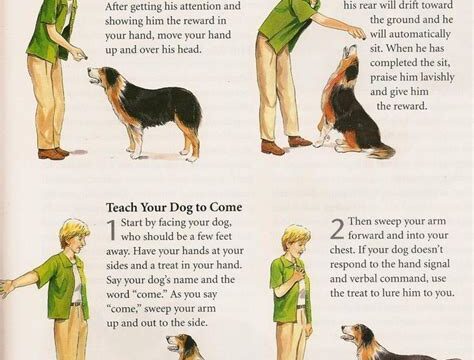Learn how to understand and train your dog effectively with positive reinforcement techniques, address behavior problems, and maintain consistent training for a well-behaved pet.
Understanding Your Dog’s Behavior
Dogs are incredibly complex creatures with their own unique personalities, behaviors, and quirks. It’s important for pet owners to take the time to understand their dog’s behavior in order to build a strong and healthy relationship with them. By paying attention to their body language, vocalizations, and reactions to different stimuli, you can start to decipher what your dog is trying to communicate to you.
It’s also important to recognize that a dog’s behavior is often shaped by their past experiences, genetics, and environment. For example, a dog that was rescued from a shelter may have different fears and anxieties compared to a dog that was raised in a loving and stable home. Understanding these factors can help pet owners better address their dog’s behavioral issues and provide the necessary support and training.
Overall, by taking the time to observe and understand your dog’s behavior, you can create a stronger bond with your pet and make training and communication more effective and positive for both of you.
Establishing a Training Routine
When it comes to training your dog, it’s important to establish a routine early on. Consistency is key when teaching your pet new skills and behaviors, so creating a solid schedule for training sessions is crucial. Set aside specific times each day to work with your dog, whether it’s in the morning, afternoon, or evening. This will help your dog understand when to expect training and will make the process more effective.
Another important aspect of establishing a training routine is finding a designated training area. This could be a specific room in your home, a corner of the backyard, or even a spot at the local park. By consistently using the same space for training sessions, your dog will begin to associate that area with learning and training, making it easier for them to focus and understand what is expected of them.
Lastly, when establishing a training routine, it’s important to set realistic goals and expectations. Rome wasn’t built in a day, and your dog won’t learn all their commands and behaviors overnight. Take it one step at a time, and be patient with your pet as they learn and grow. By setting small, achievable goals for each training session, you’ll be able to track your dog’s progress and celebrate their successes along the way.
Basic Obedience Commands
Basic obedience commands are essential for any dog owner looking to establish a foundation of good behavior and communication with their pet. Teaching your dog these commands not only helps to ensure their safety and well-being, but also fosters a strong bond between you and your furry friend.
One of the most important basic obedience commands is sit. This command can be easily taught by using treats and positive reinforcement. Start by holding a treat in front of your dog’s nose and then slowly raise it above their head, causing them to naturally sit down. Once they are in the sitting position, give the command sit and reward them with the treat. Repeat this process several times until your dog associates the word sit with the action of sitting.
Another crucial command is stay. This command is vital for your dog’s safety, especially in potentially dangerous situations. Begin by instructing your dog to sit, and then hold out your hand towards them and say stay in a firm but gentle tone. Step back a few paces, and if your dog remains in place, reward them with a treat and praise. Gradually increase the distance and duration of the stay command as your dog becomes more comfortable with the concept.
Positive Reinforcement Techniques
Positive reinforcement is an effective training technique that focuses on rewarding your dog for good behavior rather than punishing them for bad behavior. This technique emphasizes the use of treats, praise, and other rewards to encourage your dog to repeat the desired behavior. By using positive reinforcement, you can create a strong bond with your pet and make training more enjoyable for both of you.
One of the key principles of positive reinforcement is timing. It’s important to reward your dog immediately after they exhibit the desired behavior, so they can make a clear connection between the behavior and the reward. Consistency is also crucial for this technique to be effective, as your dog needs to understand that the reward is always associated with the specific behavior you want to reinforce.
When using positive reinforcement, it’s important to use a variety of rewards to keep your dog motivated and engaged. This could include using their favorite treats, verbal praise, toys, or even extra playtime. By understanding what motivates your dog, you can tailor your rewards to their preferences, making the training process more effective and enjoyable for both of you.
Addressing Behavior Problems
Addressing behavior problems in dogs can be challenging, but it is an essential part of ensuring a harmonious relationship between you and your pet. Whether your dog is displaying aggression, separation anxiety, or destructive behavior, it’s important to address these issues early on to prevent them from escalating.
One of the first steps in addressing behavior problems is to observe and understand the underlying cause of the behavior. This may involve seeking the help of a professional dog trainer or behaviorist, who can provide valuable insights into your dog’s triggers and motivations.
Once you have identified the root cause of the behavior problem, it’s important to use positive reinforcement techniques to modify your dog’s behavior. This involves rewarding your dog for displaying the desired behavior, and providing clear and consistent cues to communicate your expectations.
Advanced Training Strategies
When it comes to advanced training strategies for your dog, it’s important to continue building on the foundation of basic obedience commands and positive reinforcement techniques. One important strategy is to introduce more complex commands and behaviors, such as agility training, trick training, and advanced obedience tasks. These types of challenges can help keep your dog mentally stimulated and engaged, and can also strengthen the bond between you and your pet.
Another advanced training strategy to consider is incorporating distractions into your training sessions. This can help your dog learn to focus and follow commands in real-world environments, which is essential for their overall obedience and behavior. Gradually exposing your dog to different distractions, such as other animals, noises, and unfamiliar objects, can help them become more adaptable and well-behaved in any situation.
Consistency and patience are key components of advanced training strategies. As you introduce more complex commands and behaviors, it’s important to remain patient and consistent in your training approach. It’s also essential to continue providing positive reinforcement and rewards for good behavior, while redirecting and correcting unwanted behaviors. With time and dedication, these advanced training strategies can help your dog become a well-rounded and obedient companion.
Maintaining Consistent Training
Consistency is key when it comes to maintaining your dog’s training. It’s important to establish a routine and stick to it in order to reinforce the behaviors you want to see in your pet. Whether it’s daily walks, regular feeding times, or consistent commands, your dog will thrive in an environment where they know what to expect.
Consistency also means being on the same page with everyone in your household. Make sure that everyone who interacts with your dog is using the same commands and practicing the same training techniques. This will prevent any confusion for your pet and help them understand expectations more clearly.
Another important factor in maintaining consistent training is to use positive reinforcement. Rewarding good behavior with treats, praise, or playtime will encourage your dog to continue obeying commands and behaving well. On the flip side, it’s crucial to avoid rewarding negative behaviors, as this can undo all the hard work you’ve put into training.
Frequently Asked Questions
What are the basic commands to teach a dog?
The basic commands to teach a dog are sit, stay, come, down, and leave it.
How do I potty train my dog?
To potty train your dog, establish a routine, take them outside frequently, and reward them for going to the bathroom outside.
What are some effective training methods for dogs?
Positive reinforcement, clicker training, and consistency are all effective training methods for dogs.
How long does it take to train a dog?
The time it takes to train a dog varies depending on the dog’s breed, age, and temperament, but it generally takes several weeks to several months to fully train a dog.
What should I do if my dog is not responding to training?
If your dog is not responding to training, reassess your methods, be patient, and consider seeking help from a professional trainer.
Is it important to socialize my dog during training?
Yes, it is important to socialize your dog during training to ensure they are well-adjusted and comfortable around other dogs and people.
What are some common training mistakes to avoid?
Some common training mistakes to avoid include inconsistency, using punishment-based methods, and expecting too much too soon from your dog.





